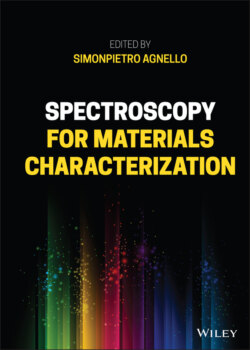Читать книгу Spectroscopy for Materials Characterization - Группа авторов - Страница 44
2.2.3.1 Tunable Laser
ОглавлениеThe tunable laser is an integrated system that provides the excitation radiation with a wavelength that can be conveniently adjusted within a wide spectral range covering UV‐Visible‐IR. A very common example exploits the third harmonic of a Q‐switched Nd:YAG laser (355 nm) to pump an optical parametric oscillator (OPO) that converts it into a tunable output.
The laser active medium is a crystal of yttrium‐aluminum‐garnet (YAG) doped with Nd3+ ions, which is pumped by a flashed Xenon lamp via the ∼800 nm Nd3+ absorption transition. The Q‐switching is triggered by an electro‐optic crystal (Pockel cell, PC) placed within the laser cavity. When the PC is not polarized, the cavity Q‐factor is low and the population inversion is high without any laser oscillations. When the PC is polarized, the Q‐factor suddenly increases and the laser action starts with a strong initial inversion, thus resulting in the buildup of an intense pulse (~102 mJ, ~5 ns long).
The laser beam at λ 0 = 1064 nm (fundamental harmonic) produced by the Nd:YAG laser is directed on a second harmonic generator (SHG), where the wavelength is converted to λ 0/2 = 532 nm, and then on a third harmonic generator (THG), where it is converted to λ 0/3 = 355 nm. The SHG and THG are nonlinear KD*P (KH2PO4) birefringent crystals, cut at the proper angle for the required wavelength. The nonlinear conversion process critically depends on the relative orientation of the polarization axis of the incident beam and the axes of the nonlinear crystals. The maximum efficiency is obtained when the phase matching is verified; it requires that the phase velocities of the frequency‐doubled and the incident waves are the same within the crystal.
Then, the third harmonic of frequency ω p traverses the OPO, a birefringent nonlinear BBO (β‐BaB2O4) crystal, and is converted into two beams, signal and idler, with frequencies ω s and ω i , respectively. Because of the energy conservation, the following condition applies:
(2.73)
To achieve the phase matching condition within the OPO, the conservation of momentum has to be fulfilled as well:
(2.74)
The previous equation can be written in the form:
(2.75)
where n p , n s , and n i are the refractive indices of the nonlinear crystal at the frequencies ω p , ω s , and ω i , respectively. Since the refractive index depends on the polarization of the light and the angle of incidence with respect to the optical axis of the BBO crystal, the OPO output can be thus continuously tuned over a wide spectral range by varying the crystal orientation. The idler polarization is perpendicular to the optical bench while the signal polarization is parallel; then a polarizer is placed in front of the OPO to select one of them. Usually, the signal wavelength can be varied from 410 to 710 nm and the idler wavelength from 710 to 2400 nm. Moreover, the output wavelength range can be extended down to 210 nm by suitable UV modules, SHG nonlinear crystals, that halve the wavelength of the OPO beam. In such tunable laser systems, the beam intensity can reach tens of mJ pulse−1, the linewidth is ~1 meV.
